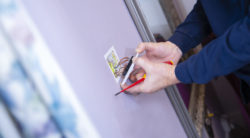
How do you bleed a radiator: A step by step guide
Is your home feeling a bit chilly despite having the heating on? Maybe you’re hearing odd sounds coming from your radiators. Before you hit the panic button, there’s a simple fix that could have your heating system running smoothly again in no time: bleeding your radiators. Follow this step by step guide and a video to help you out.
Step 1: Ensure your heating is turned off
Before you start, turn off your heating system to prevent any hot water from spilling out while bleeding the radiator.
😱 Common Mistake: Forgetting to turn off the heating can lead to burns or scalds from hot water.
Step 2: Locate the bleed valve
Familiarise yourself with the location of the bleed valve on your radiator. It’s typically found at the top, either on the side or at the back.
😱 Common Mistake: Trying to bleed the wrong valve or attempting to force open a valve that’s not designed for bleeding can cause damage.
Step 3: Place your container and towel
Prepare a container to catch any water and a towel to clean up spills. This prevents water damage to your floors or carpets.
😱 Common Mistake: Not having a container ready can lead to messy spills and potential damage to your property.
Step 4: Open the valve and release air
Use a radiator key or a suitable tool to slowly turn the bleed valve anticlockwise. Be prepared for a hissing sound as trapped air escapes.
😱 Common Mistake: Opening the valve too quickly or too far can result in water spraying out uncontrollably.
Step 5: Close the valve and clean up
Once all the air has been released and water starts to flow steadily, carefully close the bleed valve by turning it clockwise. Wipe away any excess water with a towel.
😱 Common Mistake: Leaving the valve open or not tightening it properly can lead to water leakage and loss of heating efficiency.
What happens if you bleed a radiator with the heating on?
Bleeding a radiator with the heating on poses several risks. Firstly, there’s a significant risk of burns from hot water escaping when the radiator is opened. It can also result in inefficient air removal, as the hot water circulating can create pressure that prevents trapped air from escaping effectively. This can lead to increased pressure variation within the system, potentially causing damage. It can also mean the process is messy, increasing the risk of water damage to floors and carpets if spills occur. Finally, bleeding a radiator with the heating on may actually introduce more air into the system, counteracting the intended purpose of removing air pockets.
Understanding when your radiator needs bleeding
Key signs that indicate a radiator needs bleeding include cold spots at the top, gurgling or hissing sounds coming from the radiator, and uneven heating throughout the room. These symptoms often occur due to trapped air obstructing the flow of hot water. By bleeding the radiator, trapped air is released, allowing hot water to circulate freely. Regularly checking for these signs and bleeding radiators as needed helps maintain optimal heating performance in your home.
How long do you bleed a radiator?
The duration for bleeding a radiator typically ranges from a few seconds to a few minutes. It’s essential to continue bleeding until you see a steady stream of water without any air bubbles escaping. Once this occurs, it indicates that trapped air has been successfully released, and it’s time to securely close the bleed valve to prevent further water leakage.
What tools do you need to bleed a radiator?
- Radiator key: Essential for turning the bleed valve securely.
- Towels or cloths: Used to catch spills and wipe down the radiator.
- Container: Needed to collect any water that may escape during bleeding.
- Pliers or adjustable wrenches: Optional tools for loosening stubborn valves.
Most of these tools are commonly found at home. However, if you don’t have them, they are affordable and readily available online or at most DIY stores.
Conclusion
In this guide, we’ve provided a step-by-step process for bleeding your radiator, emphasising safety precautions and common mistakes to avoid. We’ve highlighted the importance of recognising signs indicating the need for bleeding and understanding the duration of the process. If you need further assistance, please get in touch. Keep your home warm and efficient by bleeding your radiators when necessary.
Additional FAQs
- Is it necessary to bleed radiators?
Yes, bleeding radiators is necessary for maintaining optimal heating performance and ensuring even heat distribution throughout your home.
- What happens if you don’t bleed air from the radiator?
If you don’t bleed air from the radiator, trapped air pockets can obstruct the flow of hot water, leading to uneven heating, cold spots, and reduced heating efficiency.
- How often should radiators be bled?
Radiators should be bled whenever signs of trapped air are noticed, typically a few times per year, depending on usage and the specific heating system.
- Do you let all the water out when bleeding a radiator?
No, you only let out air when bleeding a radiator, not water.


